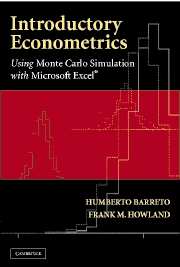Book contents
- Frontmatter
- Contents
- Preface
- User Guide
- 1 Introduction
- PART 1 DESCRIPTION
- PART 2 INFERENCE
- 9 Monte Carlo Simulation
- 10 Review of Statistical Inference
- 11 The Measurement Box Model
- 12 Comparing Two Populations
- 13 The Classical Econometric Model
- 14 The Gauss–Markov Theorem
- 15 Understanding the Standard Error
- 16 Confidence Intervals and Hypothesis Testing
- 17 Joint Hypothesis Testing
- 18 Omitted Variable Bias
- 19 Heteroskedasticity
- 20 Autocorrelation
- 21 Topics in Time Series
- 22 Dummy Dependent Variable Models
- 23 Bootstrap
- 24 Simultaneous Equations
- Glossary
- Index
22 - Dummy Dependent Variable Models
from PART 2 - INFERENCE
Published online by Cambridge University Press: 05 June 2012
- Frontmatter
- Contents
- Preface
- User Guide
- 1 Introduction
- PART 1 DESCRIPTION
- PART 2 INFERENCE
- 9 Monte Carlo Simulation
- 10 Review of Statistical Inference
- 11 The Measurement Box Model
- 12 Comparing Two Populations
- 13 The Classical Econometric Model
- 14 The Gauss–Markov Theorem
- 15 Understanding the Standard Error
- 16 Confidence Intervals and Hypothesis Testing
- 17 Joint Hypothesis Testing
- 18 Omitted Variable Bias
- 19 Heteroskedasticity
- 20 Autocorrelation
- 21 Topics in Time Series
- 22 Dummy Dependent Variable Models
- 23 Bootstrap
- 24 Simultaneous Equations
- Glossary
- Index
Summary
Bliss invented a procedure he called “probit analysis.” His invention required remarkable leaps of original thought. There was nothing in the works of Fisher, or “Student,” or of anyone else that even suggested how he might proceed. He used the word probit because his model related the dose to the probability that an insect would die at that dose.
David SalsburgIntroduction
In earlier chapters, we have created and interpreted dummy independent variables in regressions. We have seen how 0/1 variables such as Female (1 if female, 0 if male) can be used to test for wage discrimination. These variables have either/or values with nothing in between. Up to this point, however, the dependent variable Y has always been essentially a continuous variable. That is, in all the regressions we have seen thus far, from our first regression using SAT scores to the many earnings function regressions, the Y variable has always taken on many possible values.
This chapter discusses models in which the dependent variable (i.e., the variable on the left-hand side of the regression equation, which is the variable being predicted) is a dummy or dichotomous variable. This kind of model is often called a dummy dependent variable (DDV), binary response, dichotomous choice, or qualitative response model.
Dummy dependent variable models are difficult to handle with our usual regression techniques and require some rather sophisticated econometrics. In keeping with our teaching philosophy, we present the material with a heavy emphasis on intuition and graphical analysis.
Information
- Type
- Chapter
- Information
- Introductory EconometricsUsing Monte Carlo Simulation with Microsoft Excel, pp. 663 - 708Publisher: Cambridge University PressPrint publication year: 2005
